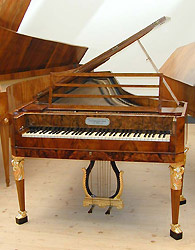
Description of the project
The KIViR project (Keyboard Instruments Virtual Restoration) addresses the case of historical keyboard music instruments present in museums worldwide. These instruments often cannot be played in a satisfactory way and need to come back to life again. In this project, we concentrate on string keyboard instruments such as pianos and harpsichords. A broader extension to other instrument categories might be considered in the future.
Museums currently involved in the project are: Schloss Kremsegg, A-4550 Kremsmünster, Austria and Handelhaus, D-06108, Halle, Germany.
See the list of pianoforte virtual copies from these museums.The usual way of bringing instruments to life again consists in restoring them properly, by repairing structure components like soundboard, pinblock, frame, or by replacing worn parts like strings, hammers or other fragile elements made of felt or skin, which fall into disrepair in course of time.
Such restorations can give excellent results and have always been practised. However, a new trend has recently appeared, consisting in the will of conservation and safeguarding of the original instrument manufacturing, particularly if it has great historical value. Besides, it may be risky to put a given instrument under full load (which reaches several tons). In such a case, one may choose to tune only a part of the notes. In both of these situations, we are faced to the following problem: only some of the notes are working correctly, and it is thus impossible to play music on such an instrument.
Digital restoration is a new experimental and innovating technology issued from recent research at the Institute of Mathematics of Toulouse, at INSA, Toulouse, France, which attempts to solve the above mentioned problem. By the use of mathematical and physical models, it reconstructs the missing notes on a computer with the help of recordings of the existing notes which sound correctly. These models can be numerically tuned and voiced in order to correct some defects issued from recording, tuning or regulation difficulties. The obtained model can then be loaded into a computer connected to a digital keyboard which can be played by all museum visitors and musicians, allowing them to retrieve, as far as possible, the original sound of the instrument.
The advantage of this technique is the following: it becomes possible to bring an historical instrument to life again, while keeping the major part untouched at its original state.
The objective of the project is to perform digital reproduction and restorations of historical keyboard instruments, and to install sound devices in museums with the purpose to allow the public to play these restored versions on a digital keyboard, standing for example near the original instrument. Of course, even if an historical instrument is in a good condition, it remains fragile and one cannot allow each visitor in the museum to play the instrument. Thus having a digital copy which can be played on a sound device should be a good idea in all cases.
In that way, the museums participating to the project will offer to the public a patrimony that was up to now not directly accessible. Moreover, the digital sounds issued from restoration will be shared by all museums participating to the project through the Pianoteq software and its instruments. These museums will thus at the same time increase the public interest in their collection.
On a long-term basis, we aim to build a considerable collection of digital copies (original or restored) of historical instruments from all parts of the world. The collection will not only serve as a maintainable testimony of the past, with playable devices in museums available to the public, but will also provide data sources for creating new virtual instruments.
